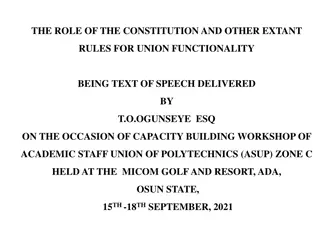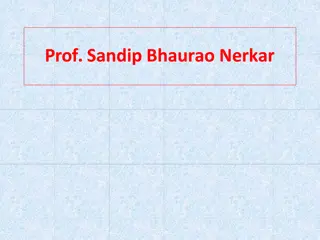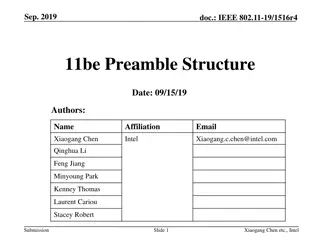Overview of the Preamble to the Constitution of India
The Preamble to the Constitution of India serves as a concise introduction, outlining the foundational principles and objectives of the nation, including sovereignty, socialism, secularism, democracy, justice, liberty, equality, and fraternity. It reflects the vision of the framers and sets the tone for the governance of India.
Download Presentation

Please find below an Image/Link to download the presentation.
The content on the website is provided AS IS for your information and personal use only. It may not be sold, licensed, or shared on other websites without obtaining consent from the author.If you encounter any issues during the download, it is possible that the publisher has removed the file from their server.
You are allowed to download the files provided on this website for personal or commercial use, subject to the condition that they are used lawfully. All files are the property of their respective owners.
The content on the website is provided AS IS for your information and personal use only. It may not be sold, licensed, or shared on other websites without obtaining consent from the author.
E N D
Presentation Transcript
PREAMBLE TO THE CONSTITUTION OF INDIA BY : SMRITI ROY ASSISTANT PROFESSOR [LAW]
INTRODUCTION Derived from a Latin term PREAMBLUS which means to go before . The idea of preamble is taken from the American Constitution It is the summary of constitution, essence/reflection of constitution. It presents the intention of its framers, the history behind its creation, and the core values and principles of the nation. The preamble basically gives idea of the following things objects: a) Source of the Constitution b) Nature of Indian State c) Statement of its objectives d) Date of its adoption
FAMOUS QUOTES FAMOUS QUOTES Soul of the Constitution by Thakur Das Bhargava Political horoscope of Indian Constitution by KM Munshi Identity card of the Constitution by N.A. Palkhivala Key note of constitution of India by Sir Ernest Barker
History of the Preamble to Indian History of the Preamble to Indian Constitution Constitution The ideals behind the Preamble to India s Constitution were laid down by Jawaharlal Resolution, on 13, December 1946. Nehru s Objectives It was adopted by the Constituent Assembly on January 22, 1947.
Components of Preamble Components of Preamble It is indicated by the Preamble that the source of authority of the Constitution lies with the people of India. Preamble declares India to be a sovereign, socialist, secular and democratic republic. The objectives stated by the Preamble are to secure justice, liberty, equality to all citizens and promote fraternity to maintain unity and integrity of the nation. The date is mentioned in the preamble when it was adopted i.e. November 26, 1949.
Sovereign: The word sovereign refers to a state which is free to conduct its own affair both internally and externally. India became a sovereign on the date of 26th January 1950 before this India was a Dominion that means it had external influence of England Now India has its own independent authority and it is not a dominion of any other external power. In the country, the legislature has the power to make laws which are subject to certain limitations.
Socialist: The term means the achievement of socialist ends through democratic means (democratic socialism). Indian socialism is a blend of Marxism and Gandhism, leaning heavily towards Gandhian socialism. India has a unique idea of socialism, we don t purely follow communist or Marxist socialism, in which the state has full control over the resources and distributes them equally. In India we follow the Ghandhian socialism, here the state doesn t directly distribute the resources but gives equal opportunity to all individuals to earn the resources. It holds faith in a mixed economy where both private and public sectors co-exist side by side. It was added in the Preamble by 42 nd Amendment, 1976.
Secular: The term has a western meaning, it means divorce or no relation between the state and religion (panthnirpeksha) but in India secularism is used in a sense which means that all the religions in India get equal respect, protection and support from the state (sarva dharma sambhav). It was incorporated in the Preamble by 42 nd Constitutional Amendment, 1976.
Democratic: The term implies that the Constitution of India has an established form of Constitution which gets its authority from the will of the people expressed in an election. The people of India elect their governments (through free, fair and periodic elections at all levels Union, State and local) by a system of universal adult franchise; popularly known as One man one vote . Republic: The term indicates that the head of the state is elected by the people. In India, the President of India is the elected head of the state
Objectives of the Indian Constitution Objectives of the Indian Constitution Justice: It is necessary to maintain order in society that is promised through various provisions of Fundamental Rights and Directive Principles of State Policy provided by the Constitution of India. It comprises three elements, which are social, economic, and political (Tag line of Russian Revolution/constitution). Liberty: The term Liberty means freedom for the people to choose their way of life, have political views and behavior in society. Liberty does not mean freedom to do anything; a person can do anything but in the limit set by the law.
Equality: The term Equality means no section of society has any special privileges and all the people have given equal opportunities for everything without any discrimination. Everyone is equal before the law. Fraternity: The term Fraternity means a feeling of brotherhood and an emotional attachment with the country and all the people. Fraternity helps to promote dignity and unity in the nation. The concept of Liberty, Equality, and Fraternity in our Preamble was adopted from the French Motto of the French Revolution.
Status of Preamble Status of Preamble The preamble being part of the Constitution is discussed several times in the Supreme Court. It can be understood by reading the following two cases. In Re Berubari Case 1960: the Court stated that Preamble is the key to open the mind of the makers but it cannot be considered as part of the Constitution. Therefore it is not enforceable in a court of law.
Kesavananda Bharati v. State of Kerela 1973: In this case, for the first time, a bench of 13 judges was assembled to hear a writ petition. The Court held that: The Preamble of the Constitution will now be considered as part of the Constitution. The Preamble is not the supreme power or source of any restriction or prohibition but it plays an important role in the interpretation of statutes and provisions of the Constitution.























